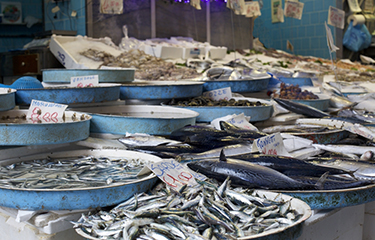The E.U. is the number one consumer of fishery and aquaculture products in the world, but with demand far exceeding supply and only limited room for growth in domestic production, the bloc is increasingly sourcing products from around the world in order to meet market requirements, confirms new analysis from the European Market Observatory for Fisheries and Aquaculture Products (EUMOFA).
In its latest review of seafood trade trends, EUMOFA finds that in 2018, E.U. imports from third-countries increased by 4 percent in volume and 2 percent in value over the previous year, reaching 6 million metric tons (MT) with a value of EUR 25.9 billion (USD 29.2 billion). However, it also established that the average unit value of these imports fell by 2 percent to EUR 4.17 (USD 4.70) per kilogram, which, it said, caused the slow growth in overall import value.
Salmonids (USD 6.5 billion, EUR 5.8 billion), crustaceans (USD 5.4 billion, EUR 4.8 billion) and groundfish (USD 5.1 billion, EUR 4.5 billion) were the most imported commodity groups, representing 58 percent of total extra-E.U. import value.
The groundfish category, which increased by 5 percent or EUR 203 million (USD 228.6 million); fish for non-food use, which was 27 percent or EUR 189 million (USD 212.9 million) more; and cephalopods, up by 6 percent or EUR 151 million (USD 170.1 million); were the main contributors to the overall increase in the extra-E.U. import value compared to 2017.
Meanwhile, the largest decrease in value was recorded for crustaceans, which fell by 3 percent or EUR 154 million (USD 170.1 million) year-on-year, mainly due to the fall in warmwater shrimp prices. An 18 percent or EUR 100 million (USD 112.6 million) decrease in value was also observed for bivalves and other mollusks and aquatic invertebrates.
Of the total volume of products imported, groundfish experienced by far the largest increase, growing by 110 million MT, or about 40 percent of the total increase for all products.
The E.U. imports fisheries and aquaculture products from nearly 150 countries around the world, but in 2018 almost 50 percent of the total value, or EUR 12.1 billion (USD 13.6 billion), was sourced from only five countries: Norway, with EUR 6.5 billion (USD 7.3 billion), up 2 percent, compared to 2017; China, with EUR 1.8 billion (USD 2 billion), an increase of 0.5 percent; and Ecuador, with EUR 1.3 billion (USD 1.5 billion), an increase of 2 percent. Also providing EUR 1.3 billion worth of products were Morocco (up 3 percent) and Iceland (up 16 percent).
Among the countries with the biggest reductions in E.U. import trade were India, down 19 percent; the Faroe Islands down 10 percent; and Thailand, down 15 percent.
The E.U.’s exports to third-countries, meanwhile, grew more rapidly last year – up by 5 percent in volume and 4 percent in value to 2 million MT valued at EUR 5.1 billion (USD 5.7 billion). This growth was largely propelled by tuna and tuna-like species, which increased in value by 15 percent or EUR 101 million (USD 113.8 million) over 2017. Other commodity groups with significant gains included crustaceans with an increase of 17 percent or EUR 77 million (USD 86.7 million) year-on-year, groundfish – 14 percent or EUR 51 million (USD 57.4 million) more, and cephalopods – up 18 percent or EUR 33 million (USD 37.2 million).
The largest declines in E.U. exports were experienced by salmonids, which registering a drop of 7 percent or EUR 53 million (USD 59.7 million), and small pelagics which were down 4 percent or EUR 26 million (USD 29.3 million) year-on-year.
Of the 182 countries to which E.U. exports were destined in 2018, five markets accounted for 48 percent or EUR 2.5 billion (USD 2.8 billion) of the total export value. EUMOFA noted that exports to China grew by EUR 170 million (USD 191.5 million) in 2018, but sales to the E.U.’s second largest market, the United States, fell by 4 percent.
The Intra-EU trade, i.e. between member states, continued to slightly exceed imports from non-E.U. countries, growing by 3 percent in volume and 2 percent in value, totaling 7 million MT and valued at EUR 27.3 billion (USD 30.7 billion).
Salmonids are the most traded species among E.U. member states, with 2018’s volume totaling 1 million MT with a value of EUR 8.4 billion (USD 9.5 billion). The groundfish trade reached 993,000 MT and EUR 3.6 billion (USD 4.1 billion), and crustaceans totaled 343,000 MT with a value of EUR 3.1 billion (USD 3.5 billion).
The largest increase in intra-E.U. export values was seen in salmonids, which grew by 6 percent or EUR 475 million (USD 535 million). In volume terms, this trade increased by 9 percent or 90,000 MT over 2017.
Groundfish also registered significant gains, up by 9 percent in volume and 4 percent in value from the previous year.
Consequently, the E.U. trade balance in fisheries and aquaculture products continued to run in the red, showing the region’s increasing dependence on imported products. In fact, its fisheries and aquaculture trade deficit reached a record loss of EUR 20.8 billion (USD 23.4 billion), 2 percent greater compared with 2017. Measured in volume terms, the trade deficit grew even larger, importing 4 million MT more than exporting, an increase of 4 percent.







